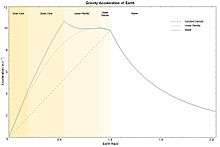Preliminary reference Earth model

The Preliminary reference Earth model (PREM) is a one-dimensional model representing the average Earth properties as a function of planetary radius.[1] It includes a table of Earth properties, including elastic properties, attenuation, density, pressure, and gravity, as a function of planetary radius.
PREM has been widely used as the basis for seismic tomography and related global geophysical models .[2] It incorporates anelastic dispersion and anisotropy and therefore it is frequency-dependent and transversely isotropic for the upper mantle.
PREM was developed by Adam M. Dziewonski and Don L. Anderson in response to guidelines of a "Standard Earth Model Committee" of the International Association of Geodesy (IAG) and the International Association of Seismology and Physics of the Earth's Interior (IASPEI) Other Earth reference models include iasp91[3] and ak135.[4]
References
- ↑ Dziewonski, Adam M.; Anderson, Don L. (June 1981). "Preliminary reference Earth model". Physics of the Earth and Planetary Interiors. 25 (4): 297–356. doi:10.1016/0031-9201(81)90046-7.
- ↑ Dziewonski, A. M.; Romanowicz, and B.A. (2007). "1.01 - Overview". Treatise on Geophysics, edited by Gerald Schubert. Elsevier, Amsterdam: 1–29, ISBN 9780444527486. doi:10.1016/B978-044452748-6.00001-8.
- ↑ Kennett, B.L.N. (1991). IASPEI 1991 Seismological Tables. Canberra, Australia,: Bibliotech,.
- ↑ Kennett, B. L. N.; Engdahl, E. R.; Buland, R. (1995-07-01). "Constraints on seismic velocities in the Earth from traveltimes". Geophysical Journal International. 122 (1): 108–124. ISSN 1365-246X. doi:10.1111/j.1365-246X.1995.tb03540.x.
External links
- IRIS EMC - Reference Earth Models
- Table of values in PREM model
- Model formulas, inputs, and overview